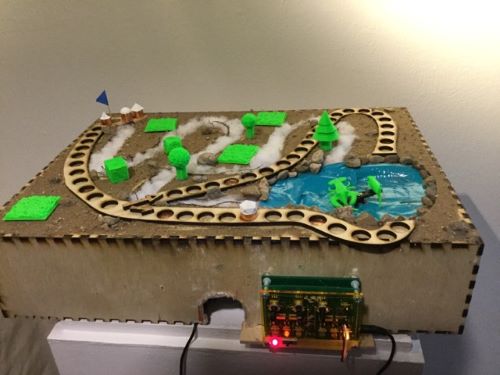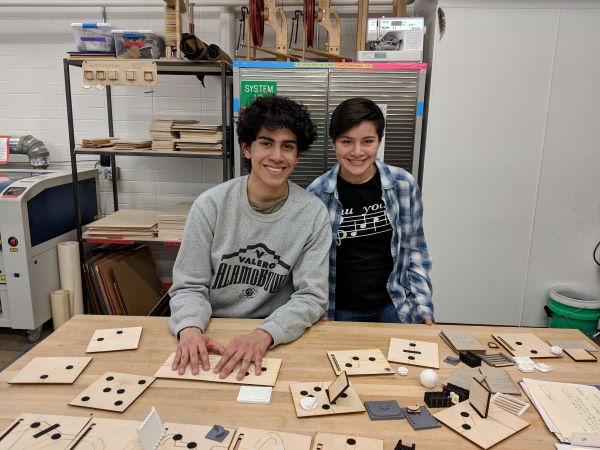Colorado Teens Use Makerspace To Create Accessible Board Games
In an award-winning internship at the Boulder Public Library, underserved youth work in the makerspace to design and create projects that can improve the community. This year, two teens built board games that are inclusive of players with visual disabilities.
While visiting the Boulder Public Library (CO), I couldn’t decide which part of the building I admired more: the rooftop garden with a beehive, the art gallery featuring a teardrop camper made as an act of female empowerment, or their amazing makerspace, BLDG 61. Creative Technologist and BLDG 61 cofounder Janet Hollingsworth showed me around BLDG 61. The whir of the multiple 3-D printers coinciding with their massive laser cutter had me awestruck. But most impressive were the two teens I met in Boulder, and their inspirational work that will change our future.
Boulder Public Library hosts an award-winning internship for underserved youth within their community. In this internship, kids are paid in gift cards while working in the makerspace to design and create projects that can improve the community. During their internship, they learn firsthand how to operate technology and machinery like the laser cutter, as well as circuitry and programming. The University of Colorado’s Build a Better Book project inspired their first creative prompt: to make something that could improve the lives of the visually impaired. Build a Better Book is a National Science Foundation–funded operation that helps create tactile books for those who have visual and print disabilities. They host workshops and other professional development opportunities to teach advocates nationwide how to continue their mission and spread the knowledge and benefits beyond their location. I was one of about 35 lucky enough to be selected in this year’s workshop.
One of the most prolific interns from BLDG 61’s first year was 17-year-old Jerónimo Barrios Palacios Luna. When Build a Better Book presented its mission, he was inspired to create something “more dynamic,” than books. He made a raised board game to replicate the nearby river landscape. The game, named “To Catch the Lobster,” or “Atrapa la Langosta,” has its own vocabulary of textures, includes braille, and features sound-bites that read the game cues in English and Spanish. Jerónimo learned from mentors with visual impairment that textures are more important than the visual appearance.
 |
Jerónimo Barrios Palacios Luna's game “To Catch the Lobster,” or “Atrapa la Langosta.”Photo courtesy of Adriana Paola Palacios Luna. |
While on our tour with Build a Better Book, Neal Mckenzie was thoroughly impressed with the game. As an assistive technology specialist who works with K–12 blind and low vision students in Sonoma County, CA, he organizes social get-togethers for this community and has encountered a lack of entertainment options. “Most everyone with typical sight including myself grew up playing so many types of social games and have carried that love of games on into adulthood,” he said. “This is sadly not the case with those who are blind and visually impaired. Although there a few titles and smaller companies that produce accessible games, the low production and availability leave a huge hole in this area.”
Jerónimo’s creative success inspired many more accessible gaming projects during the second internship. His passion for his project spread beyond the library and into his home as well. He had so much fun that his younger sister Atzin, 13, wanted in on the action. Even though she was younger than the intended age of the internship, Hollingsworth had no hesitation bringing Atzin on board. “We feel that empowering young people to positions of mentoring others, even those older than them, is vital in developing a sense of agency around using new technologies,” she explained. “Atzin has become a thriving member of our community over the past two years. She has responsibly learned how to use and operate the laser cutter, air brush, Adobe Illustrator, sewing machines, and screen-printing equipment. By demonstrating these skills and attention to detail and willingness to share her knowledge with others, we all agreed that she would contribute a great deal to the summer internships at BLDG 61.”
Not only had Atzin mastered the technology within the makerspace but she also became an integral cocreator of adaptive games with her brother. Together, they created a second game, tentatively called “Los Mueganos.” The name comes from a traditional Pueblan candy, but when used in the context of people means “unity,” a fitting title since this game is collaborative and puts everyone on an even playing field. Blindfolds are included and meant to be worn by sighted people while playing. The game consists of a large number of laser cut and 3-D printed pieces. All the pieces are handmade, and the braille is typed by the kids. Atzin explains their thought process: “Something that’s accessible isn’t just for blind people, but for everyone. Race, gender, everyone has to be able to enjoy what we’re making.... We feel like we’re part of a project that’s helping our community.”
 |
Jerónimo, 17, and Atzin Palacios Luna, 13, with their game Los Mueganos.Photo by Christina Keasler. |
Nearly every day of these internships, mentors with visual impairment were available for the students to consult with and ask advice. With the help of the mentors, Jerónimo and Atzin were able to troubleshoot their games to make sure they were both usable by the visually impaired community, and also work with the logistics of the game. Jerónimo explains, “We first made the braille very big so they were easy to feel, they didn’t fit in the game. If we made them too small, the pieces would be hard to identify from one another.” Atzin continues, “We don’t know what it’s like for them to live and to do everything without being able to see. So making it and making sure you can understand it without being able to see was the hardest part. Every time we [met with the mentors], we were able to add something to make it more understandable and more accessible.”
Jerónimo has been recruited by the Build a Better Book project to mentor Colorado University students and potentially re-create the internship at a collegiate level. Both Jerónimo and Atzin agreed that meeting and working with mentors with visual impairment was the most helpful part of their experience, far beyond learning any of the impressive equipment BLDG 61 has to offer.
Jerónimo has never seen anyone play his games in person, but the most rewarding thing about this experience is hearing the feedback from game testing that no player has an advantage over the other. “[It’s] as balanced as possible. Not just fun, but equal.” The siblings are pursuing publishing options for Los Mueganos. They’ve teamed up with a board game maker that also actively uses the makerspace. Because of these internships, both want to go into the engineering field when they get older. Jerónimo wants to focus on some sort of physical engineering, while Atzin wants to combine hands-on engineering with coding.
The kids have big plans for the summer, of course centered on BLDG 61. The internship this summer is designing a balloon to go to the edge of space. Jerónimo is also working on controlling the length of a ray of light.
Boulder Public Library has shown what happens when kids are given the tools to create. They can learn beyond what’s expected and use powerful equipment that places them at the cutting edge. What began as a unique internship program offered by the Boulder Public Library began a perception- and life-altering experience for these two kids who are totally going to change the world one day.
Christina Keasler is the youth technology librarian and assistant department manager at Glen Ellyn Public Library. When she's not working with the 3-D printer, she's teaching cool things to kids and staff about robots and virtual reality. Christina is also a huge advocate for middle schoolers, and a master of corny jokes.
RELATED
The job outlook in 2030: Librarians will be in demand
The job outlook in 2030: Librarians will be in demand
ALREADY A SUBSCRIBER? LOG IN
We are currently offering this content for free. Sign up now to activate your personal profile, where you can save articles for future viewing






Add Comment :-
Be the first reader to comment.
Comment Policy:
Comment should not be empty !!!